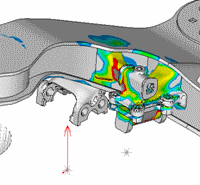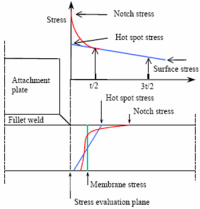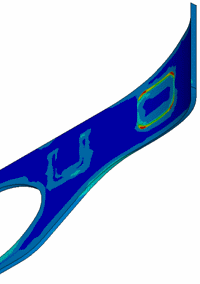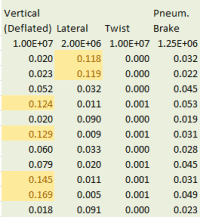|
Use our XLC calculation template to make sure that you never make
mistakes with units. One of the most common remarks in the site repository is “I wish this was in metric
units” or alternatively “I wish this was in imperial units”. Use our template and simply click from from one system of units to another. The
golden rule: ALWAYS use
consistent units.
You would think managing units was a trivial
exercise but over the years many mistakes have been made through the
incorrect use of units. Here are a couple of prominent examples:
|
|
In 1983 a Boeing 767 jet ran out of fuel in mid-flight because of two
mistakes in figuring the fuel supply of Air Canada's first aircraft
to
use metric measurements. Fortunately the crew was able to glide the
aircraft safely to an emergency landing at Gimli Industrial Park
Airport. |
 |
In 1999 NASA lost a $125 million Mars orbiter because one engineering
team used metric units while another used US customary units for a
calculation. The Mars Climate Orbiter was intended to enter orbit at
an
altitude of 140.5–150 km above Mars. However, the unit error caused
the
spacecraft to only reach 57 km. The spacecraft was destroyed by
atmospheric stresses and friction at this low altitude.
|
|
|
Our Video Guide to Handling Units in Excel |
| We have
decided to produce this video guide to help us handle
units
sensibly. We’ll show you how to make calculations with
interchangeable
units simply by the use of the XLC template. |
Repository News
The ExcelCalcs repository continues to grow and we are
delighted to receive calculations from you. Remember we
reward calculations with free XLC Pro subscriptions.
 Structural
Materials Data Steel Structural
Materials Data Steel
A workbook containing section properties and materials... Thank you InfoJunkie65.
 Timber Data
for AS1720 Timber Data
for AS1720
Workbook with tables and data relevant fortimber construction. Thank you InfoJunkie65.
 Gable
Canopy to Australian Codes Gable
Canopy to Australian Codes
Timber canopy design. Thank you InfoJunkie65.
 schTechLIB schTechLIB
Technical Libary referenced by most of my workbooks. Thank you InfoJunkie65.
 schWindAssessment schWindAssessment
Assessment of design wind speed to AS1170.2:2002, and assignment of
AS4055 wind classification. Thank you InfoJunkie65.
 Kleinlogel Kleinlogel
Various frames: rectangular, gable, and skillion, with pinned and fixed
bases. Thank you InfoJunkie65.
 load
combinations.xls load
combinations.xls

This sheet tabulates loads on connections or other structural components
and factors the loads based on strength design and allowable stress
design combinations. User can customize load combinations as needed.Thank you jpdgate.
 EXCsta2010.xls EXCsta2010.xls

Static structural analysis of 2D linear elastic frames and trusses.
Computes the static deflections, reactions, internal element forces
using direct stiffness methods. Work has started on a 3D version EXCsta_3D.xlsx perhaps you would like to get involved in its development?Thank you Turan Babacan.
 WF BEAM
AISC360-05 SECTION F2 WF BEAM
AISC360-05 SECTION F2

This is an excel spreadsheet that calculates the allowable moment
capacity of a beam with variable unbraced lengths base on section F of
the AISC360-05 specification chapter F, section F.2. I am new at this so
if anyone can improve upon it, please do so, or let me know what and
how i can improve on it. Thank you Margarito Castillo.
 2D Frame
Analysis 2D Frame
Analysis
Analysis of a 2D frame subject to distributed loads, point loads and
moments. For distributed loads specify length from the ends of the start and end
of the load, and the load intensity at the start and end.
For Point loads and moments specify the position and magnitude
Positions and load lengths are measured along the beam axis, as a ratio
of the beam length. Distributed and point load direction is either "X" (horizontal) or "Y"
(vertical). Thank you Doug Jenkins.
 Plate
Bending for Orthotropic Laminates Plate
Bending for Orthotropic Laminates

Laminated plate theory (LPT) or classical lamination theory (CLT)
is the
basic design tool for evaluating different laminates when experimental
data are not available. LPT can be used to combine properties and the
orientation of each ply in a predetermined stacking sequence to predict
the overall performance characteristics for a laminate. LPT is based on
the assumptions that the laminate deforms under conditions of plane
stress and that the strains experienced by the individual layers of the
laminate are compatible with the strains in the neighbouring layers. The
mechanical properties (i.e. the moduli and poisons ratios)of the
unidirectional composite are required before LPT can be applied and
these are best obtained from mechanical tests. In-plane loading and
loading from bending can be considered. LPT can also be used to assess
the stresses that arise through temperature and moisture changes. This
theory provides the in-plane stresses and strains for each lamina of the
laminate and can be combined with failure criteria for individual
plies. Thank you rahulmenon.
 Orthotropic
Plate Buckling and ABD Matrix Calculator Orthotropic
Plate Buckling and ABD Matrix Calculator

More laminated plate theory (LPT) calculations. Thank you again rahulmenon.
Recommended Reading
Civil engineering text books.
Structural and Stress Analysis by T.H.G. Megson
| Find on Amazon.com | Find on Amazon.co.uk | Find on Amazon.fr | Find on Amazon.de | Find on Amazon.ca |
Introduction to Design for Civil Engineers by A.W. Beeby
| Find on Amazon.com | Find on Amazon.co.uk | Find on Amazon.fr | Find on Amazon.de | Find on Amazon.ca |
Engineering Mathematics 6th Edition by K.A. Stroud
| Find on Amazon.com | Find on Amazon.co.uk | Find on Amazon.fr | Find on Amazon.de | Find on Amazon.ca |
Craig's Soil Mechanics by R.F. Craig
| Find on Amazon.com | Find on Amazon.co.uk | Find on Amazon.fr | Find on Amazon.de | Find on Amazon.ca |
Surveying for Engineers by J. Uren
| Find on Amazon.com | Find on Amazon.co.uk | Find on Amazon.fr | Find on Amazon.de | Find on Amazon.ca |
Fluid Mechanics by Dr J. F. Douglas
| Find on Amazon.com | Find on Amazon.co.uk | Find on Amazon.fr | Find on Amazon.de | Find on Amazon.ca |
Construction Materials by J.M. Illston
| Find on Amazon.com | Find on Amazon.co.uk | Find on Amazon.fr | Find on Amazon.de | Find on Amazon.ca |
Modern Architecture: A Critical History (World of Art) by Kenneth Frampton
| Find on Amazon.com | Find on Amazon.co.uk | Find on Amazon.fr | Find on Amazon.de | Find on Amazon.ca |
An Engineer Imagines by Peter Rice
| Find on Amazon.com | Find on Amazon.co.uk | Find on Amazon.fr | Find on Amazon.de | Find on Amazon.ca |
Management for Engineers, Scientists and Technologists by John V. Chelsom
| Find on Amazon.com | Find on Amazon.co.uk | Find on Amazon.fr | Find on Amazon.de | Find on Amazon.ca |
|
Consultancy Projects - Fatigue Analysis Of Welded structures

Finite element stress analysis.

Understand fatigue classification of welds.

Understand how to select appropriate stress from finite element model for fatigue assessment.

Software developed by MoreVision to take benefit from fatigue enhancement methods (like toe grinding, TIG dressing and stress relieving).

View fatigue classification directly on finite element model.

View damage directly on finite element model.

Export results to spreadsheet for detailed analysis and verification.

Fatigue assessment of rollercoasters.

Fatigue assessment of railway bodyshells and running gear.
Training Modules...
Select your own course from the ExcelCalcs training modules.
- XLC and ExcelCalcs
- Bolting and mechanical fasteners
- Welding and joining materials
- Static strength and fatigue design
- Pins and lugs
- Failure criteria and biaxial stress assessment
- Material properties and material selection
- Steel and aluminium design
- Fatigue of welded structures
- Fracture mechanics
- Strain gauge or calculate?
- Failure Investigations
- Design for impact loads and dynamic effects
|

















